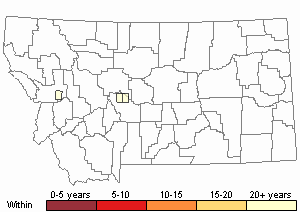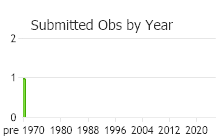View in other NatureServe Network Field Guides
NatureServe
Montana
Utah
Wyoming
Idaho
Wisconsin
British Columbia
South Carolina
Yukon
California
New York
Slender Schistidium Moss - Schistidium tenerum
Other Names:
Grimmia tenera
General Description
Plants: Acrocarpous, growing in sometimes extensive, dense carpets or cushions, the wiry stems parting from each other easily with disturbance, olive green, green with brownish tones, sometimes extremely dark (FNA 2007), older leaves turning red with yellow tones (Bremer 1980). Stems 5-40 mm in height, usually under 20 mm, possessing a well-developed central strand (FNA 2007).
Leaves: Upright and typically overlapping when dry, 0.7-1.8 mm in length, lance-shaped or deltoid, either way with ovate tendencies, tapering to an acute apex, strongly longitudinally folded above along the mid-line, cupped below; leaf edges smooth, typically curved back and down; costa extending well beyond the leaf tip, forming an awn; awn typically extending back down the leaf edges a little, slightly bent or zigzagged, with tiny sharp teeth (FNA 2007).
Leaf Cells: Lamina largely 2 cell-layers thick above, but irregularly so; upper laminal cells short and oblong to square or egg-shaped, straight to slightly wavy, smooth; lower laminal cells square or wider than long, the longitudinal cell walls occasionally thinner than the crosswise walls; leaf edges of 1 or 2 cell-layers (FNA 2007).
Phenology
Fruit ripens the last part of spring into the first part of summer (FNA 2007).
Diagnostic Characteristics
The dense carpets/cushions of wiry stems that part easily when disrupted is a distinguishing feature (FNA 2007).
Range Comments
AK to NU, BC to MB, WA, MT to CO (FNA 2007). Known in Montana from Cascade, Flathead, Glacier, Missoula, and Meagher Counties (Elliott & Pipp, 2016).
Observations in Montana Natural Heritage Program Database
Number of Observations: 4
(Click on the following maps and charts to see full sized version)
Map Help and Descriptions
Relative Density

Recency


 (Observations spanning multiple months or years are excluded from time charts)
(Observations spanning multiple months or years are excluded from time charts)
Habitat
Stones (FNA 2014), limestone and granite (Bremer 1980), in and along stone fissures; in the open or receiving dappled shade (FNA 2007). Mostly found in the Arctic; however, the plants grow in North America at high elevations in the Rocky Mountains (Bremer 1980). Occurring from lowlands to elevations of 14,760 feet (FNA 2007).
Reproductive Characteristics
Dioicous. Sporophytes and male plants seldom produced (Bremer 1980). Capsule 0.6-1.1 mm in length, deep red or brownish, cup-shaped, rather short; peristome pale brown and covered with papillae and openings. Calyptra not completely shielding the capsule (FNA 2007).
Stewardship Responsibility
References
- Literature Cited AboveLegend:
 View Online Publication
View Online Publication Bremer, B. 1980. A Taxonomic Revision of Schistidium (Grimmiaceae, Bryophyta) 2. Lindbergia 6(2):89-117.
Bremer, B. 1980. A Taxonomic Revision of Schistidium (Grimmiaceae, Bryophyta) 2. Lindbergia 6(2):89-117. Elliott, J.C. and A.K. Pipp. 2018. A Checklist of Montana Mosses (1880-2018). Updated 3 January, 2020. Montana Natural Heritage Program, Helena, Montana. 73 pp.
Elliott, J.C. and A.K. Pipp. 2018. A Checklist of Montana Mosses (1880-2018). Updated 3 January, 2020. Montana Natural Heritage Program, Helena, Montana. 73 pp. Flora of North America Editorial Committee, eds. 2007. Flora of North America North of Mexico. Volume 27. Bryophytes: Mosses, Part 1. Oxford University Press, Inc., NY. xxi + 713 pp.
Flora of North America Editorial Committee, eds. 2007. Flora of North America North of Mexico. Volume 27. Bryophytes: Mosses, Part 1. Oxford University Press, Inc., NY. xxi + 713 pp.
- Additional ReferencesLegend:
 View Online Publication
View Online Publication
Do you know of a citation we're missing? Elliot, J. C. 1993. Second checklist of Montana mosses. Unpublished report. U.S. Forest Service, Region 1. Missoula, MT. 45 pp.
Elliot, J. C. 1993. Second checklist of Montana mosses. Unpublished report. U.S. Forest Service, Region 1. Missoula, MT. 45 pp. Lawton, E. 1971. Keys for the Identification of the Mosses on the Pacific Northwest. Reprinted from 'Moss Flora of the Pacific Northwest'. Published as Supplement No. 2 of the Journal of the Hattori Botanical Laboratory. Nichinan, Miyazaki, Japan. 66 pp.
Lawton, E. 1971. Keys for the Identification of the Mosses on the Pacific Northwest. Reprinted from 'Moss Flora of the Pacific Northwest'. Published as Supplement No. 2 of the Journal of the Hattori Botanical Laboratory. Nichinan, Miyazaki, Japan. 66 pp. Lawton, E. 1971. Moss Flora of the Pacific Northwest. Hattori Botanical Laboratory. Japan: Yamabuki-cho, Shinjuku-ku, Tokyo. 362 pages plus appendices.
Lawton, E. 1971. Moss Flora of the Pacific Northwest. Hattori Botanical Laboratory. Japan: Yamabuki-cho, Shinjuku-ku, Tokyo. 362 pages plus appendices. Malcolm, B., N. Malcolm, J. Shevock, and D. Norris. 2009. California Mosses. Nelson, New Zealand: Micro-Optics Press. 430 pp.
Malcolm, B., N. Malcolm, J. Shevock, and D. Norris. 2009. California Mosses. Nelson, New Zealand: Micro-Optics Press. 430 pp.
- Web Search Engines for Articles on "Slender Schistidium Moss"





